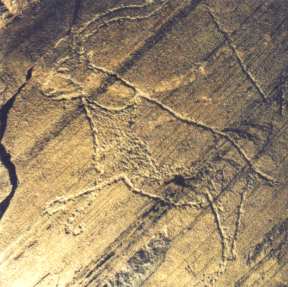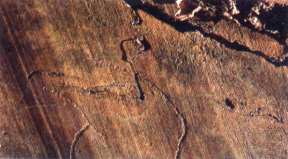|
|
|
|
WORLD HERITAGE SITES IN PORTUGAL
FOZ COA
PREHISTORIC ROCK ART OF THE COA VALLEY
Through the imposing mountains of the north-eastern region of Portugal, where in spring the almond trees are in full blossom and in autumn the vines are covered with fiery red leaves, there runs into the River Douro from the south a tributary whose name is now universally known. This is the River Coa, whose vast valley contains many examples of a long flourishing artistic cycle. Millennium after millennium, the rock formations that line the river banks have been converted into panels covered with thousands of engravings bequeathed to us by our ancestors' creative impulses. Dating back to the beginning of the Upper Paleolithic Age, these open air ''panels'' bear witness to an artistic vitality and mastery that have brought us into touch with 25,000 years past time. This extensive art gallery provides us with a record of the Neolithic period and the Iron Age, and then transports us in one fell swoop across two thousand years of history to settle in the Modern Era with its religious representations, names, dates and even, only a few decades ago, some figures drawn by the children of a local miller.
Almost all the motifs are engraved in the rock, presenting us with themes, techniques and conventions common to those other contemporary works in Western Europe which were discovered in the nineteenth century hidden in the French-Basque caves and by the turn of the century were already referred to as great art. It was, however, not until the end of the twentieth century that we were suddenly to see such art burst forth from the hidden recesses of the caves into the open air, where the daily and seasonal interplay of light and shade, brought to us by both the sunlight and the full moon, simultaneously exposes an hides it in a fantastic game of revelation and concealment.

For the last seventeen kilometres of the river's course, as it wends its way from south to north, these engraved panels are spread over a large area, reaching as far as the point where it flows into the river Douro and penetrating into the valleys of other tributary streams. The very size of this area was sufficient to dictate the creation of Portugal's first archaeological park, which since December 2, 1998 has been included in the list of monuments classified by UNESCO World Heritage. Such classification was the result of a sudden and radical change in government policy, beginning in October 1995 with the decision to suspend the already well advanced project for the building of dam designed to promote the first phase of hydroelectric development in the River Coa. The subsequent simultaneous creation of the Coa Valley Archaeological Park and the National Rock Art Centre, both of which are based in Vila Nova de Foz Coa, represented the culmination of an important decision that will clearly have a crucial effect on the status of rock art, archaeology and heritage in Portugal at various levels.The themes of the engravings are basically zoomorphic, with drawings of mountain goats, horses, aurochs (wild hulls) and deer. The first three of these species are the most common and characteristic of the earliest phases of artistic production, all of them corresponding to the large herbivores that were typical of the ecosystems of the Upper Paleolithic Age in the region.
There are also some rare engravings of fish and just one single instance of a human form, the latter occurring at the end the Upper Paleolithic Age. As was typical of Quaternary art, signs were engraved under the form of straight lines or in zigzags, with the rocks being pecked or scratched with instruments made of quartzite or flint. The engravings were made through the use of several different techniques, sometimes occurring in combination: fine line incision (resulting in motifs that are more difficult to read because of the delicacy of the marking), pecking (a succession of points hammered into the stone), abrasion and scratching of the surface. The latter technique was less common but has resulted in those panels that have the greatest visual impact. In the centre of engravings that is situated furthest upstream, at Faia, where the river flows between granite escarpments, some remains have been identified of red paintings, either covering over lines previously produced by pecking or completing engraved motifs. This fact indicates the contemporary use of the two techniques: engraving and painting.

The Iron Age, the second moment that as to decisively mark the development of this long artistic cycle, has left us with many magnificent panels of fine line engravings of figures, with an obvious fondness being shown for warriors with long legs and tiny heads, armed with swords and lances and riding stylised horses with long, thin bodies and high necks. The cycle of rock art began again in be seventeenth century with the engraving of religious and profane motifs. These were now accompanied by inscriptions and dates and continued until the mid twentieth century with various engravings depicting the terrestrial, marine and winged ''creatures'' that are most typical of our contemporary age: fish and birds, boats, trains and planes. All of this magnificent group of open air engravings, which finally lays to rest the old myth of rock art being forever enclosed in caves, is contained within the Coa Valley archaeological Park, which is itself divided to three separate centres. Visits are conducted by specialist guides, but must be booked in advance. The three centres are: Canada do Inferno, which was the first group of engravings to be discovered, very close to Vila Nova de Foz Coa, Ribeira de Piscos, at Muxagata, and Penascosa, close to the village of Castelo Melhor.Situated in the very heart of the archaeological park, the Quinta da Ervamoira provides a complementary service for visitors to the engravings. Here there is a museum that gives a full description of the region and its ancestral customs, without forgetting the extremely ancient bread making cycle and the traditional features of Douro wine production, surely yet another of this region's most undeniable riches.
Text provided by the Portuguese Tourist Office